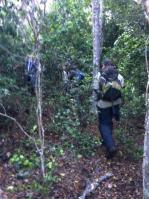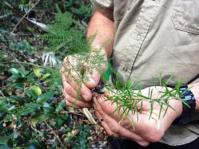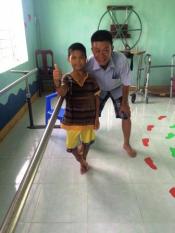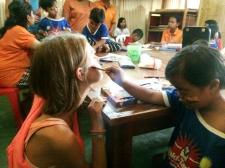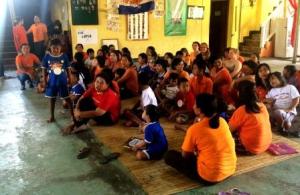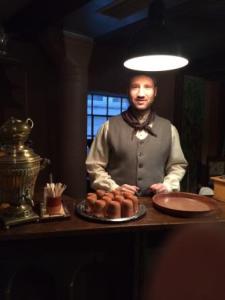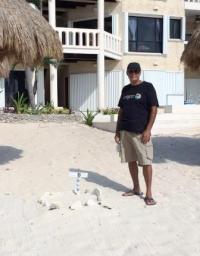
Guillermo and a sea turtle nest
On the most recent Drop Me Anywhere trip to Mexico, I had the opportunity to walk the beach in Akumal with Guillermo, from Centro Ecológico Akumal (CEA). No, we weren’t just walking for exercise, or to enjoy the beautiful view (which it was), we were inspecting the nests filled with sea turtle eggs which are scattered along the beach just waiting to hatch. Along the way, I learned about the great work CEA does, the disagreements amongst environmentalists about the best way to help the sea turtles, or even if they need help at all, and how regular people can get involved. We even saved one from a crab attack!
Who are they? CEA was formed in 1993 by the Akumal Yacht Club, whose shareholders put their four hectares of property on Akumal Bay into a trust to generate funds and provide infrastructure for environmental initiatives to protect Akumal’s coastal and marine ecosystems and biodiversity. Different than many other conservation organizations, CEA rents out some of its property to local businesses and, therefore, retains administrative control of the property, which also allows for donations made to CEA to go directly towards conservation.
What do they do? CEA’s mission is to produce and promote strategies for ecosystem management in Akumal, through research, education and policy, for sustainability in the Mexican Caribbean. These programs include:
– Coastal Ecosystems Program – the objective is to promote the protection and conservation of the coastal ecosystems through ecosystem monitoring, information sharing and management. It consists of Reef Monitoring and Research, Bay Monitoring and Patrol, Management and Maintenance, and Outreach and Environmental Education.
 – Sea Turtle Program – the objective is to protect the nesting female turtles and their hatchlings, raising awareness among visitors and residents on sea turtle biology and conservation measures. As Akumal means “Place of the Turtle,” this program is a huge focus of CEA. The sea turtle population is of vital importance to tourism, as many come to Akumal in order to snorkel with the sea turtles (in their natural habitat). It’s a delicate balance in which CEA works as a go between in order to ensure a fun and educational experience for tourists, as well as protecting the sea turtles from negative human behaviors which may endanger their future well-being. During nesting season, CEA staff and volunteers patrol the beaches of Akumal in search of nesting females and hatchlings. Their activities include protecting and tagging females, obtaining scientific data, in extreme cases, relocating eggs to more favorable locations, and hatchling releases. The data collected is used to determine how many nests were achieved, behavior, distribution and abundance. Their work includes taking tourists and visitors on these walks visitors to help teach them to respect nature and the life of sea turtles, to be more aware of other species, to learn to cohabitate with them and to help take care of their habitats.
– Sea Turtle Program – the objective is to protect the nesting female turtles and their hatchlings, raising awareness among visitors and residents on sea turtle biology and conservation measures. As Akumal means “Place of the Turtle,” this program is a huge focus of CEA. The sea turtle population is of vital importance to tourism, as many come to Akumal in order to snorkel with the sea turtles (in their natural habitat). It’s a delicate balance in which CEA works as a go between in order to ensure a fun and educational experience for tourists, as well as protecting the sea turtles from negative human behaviors which may endanger their future well-being. During nesting season, CEA staff and volunteers patrol the beaches of Akumal in search of nesting females and hatchlings. Their activities include protecting and tagging females, obtaining scientific data, in extreme cases, relocating eggs to more favorable locations, and hatchling releases. The data collected is used to determine how many nests were achieved, behavior, distribution and abundance. Their work includes taking tourists and visitors on these walks visitors to help teach them to respect nature and the life of sea turtles, to be more aware of other species, to learn to cohabitate with them and to help take care of their habitats.

Sea turtles hatching
– Water Quality Program – the objective in addressing the water quality issues in the region is to dramatically reduce the amount of waste water reaching the sea. CEA works in watershed research and protection, and promotes improved wastewater treatment technologies. This is important due to the area’s highly-porous limestone rock, which is riddled with many fractures, underground rivers and caves. These are interconnected and, in some cases, channel fresh water out to sea, much like an above-ground river might in a coastal region. This is a very fragile aquifer and the quality of its waters has a direct impact on the Caribbean Sea and the coral reef ecosystem.
– Sustainable Development Program– the objective is to influence development and lessen its impact on the local environment. CEA works with local hotels, condominiums and businesses to apply best practices for resource management. Business can become certified in Akumal and then may be listed on CEA’s website.
– Environmental Education Program – the objective is to raise awareness among locals and visitors about the fragility of our ecosystems. They provide ecology classes in schools, summer school courses and visitor information in addition to the sea turtle beach walks.
– Communication Program – Providing outreach to tourists, locals and the tourism sector, the Communication Program helps accomplish CEA’s mission by disseminating their research findings and information in order to be able to influence public policy and to help preserve the coastal environment. Through their Communication Program CEA works with writers, photographers, filmmakers, graphic artists, and anyone who can help getting word out about their important organization and programs.

Sea turtle nest
How can you help? With office space and overhead provided by its property, CEA can dedicate funds from memberships, donations, and grants to cover expenses related to its specific conservation programs. Any donations are gratefully accepted. They also depend on volunteers, students and partnerships with many other organizations to carry out their work. If you’re planning a visit to Akumal, or the nearby cities of Cancun, Playa Del Carmen or Tulum, you can arrange a visit to CEA to learn more about the sea turtles and environmental issues in the area. If you’re there at the right time of year, you may also be able to participate in a nighttime beach walk where you may run across a sea turtle and have the chance to assist in nesting, tagging, or collecting data. At other times of the year you might have the chance to walk the beach with A CEA employee or volunteer in the morning in order to check on the up to 170 nests which are laid throughout the season.*
During your next trip to this area, I’d highly recommend a stop at Centro Ecológico Akumal. Please contact them through their website listed below and ask about their educational programs or even a beach walk. It’s a great family activity (they may even be able to arrange assistance for accessibility issues) which will make a positive impact on you, your kids, and the environment.
 *Note – while walking with my guide Guillermo, we noticed some holes in a nest. Suddenly, Guillermo dropped to his knees and began digging. Once he’d dug a few inches down, a crab scurried out of the nest. We dug further and saw that the eggs were intact. If the crab had made it to the eggs, it would most likely have punctured at least one, which would then attract ants that would demolish the shells and make their way into the eggs and destroy the developing turtles inside.
*Note – while walking with my guide Guillermo, we noticed some holes in a nest. Suddenly, Guillermo dropped to his knees and began digging. Once he’d dug a few inches down, a crab scurried out of the nest. We dug further and saw that the eggs were intact. If the crab had made it to the eggs, it would most likely have punctured at least one, which would then attract ants that would demolish the shells and make their way into the eggs and destroy the developing turtles inside.
To learn more about the great work that CEA does, or to learn how you can help by donating or volunteering, please visit their website: http://www.ceakumal.org/
Tags: Akumal, Beach, Environment, Goodness, Mexico, Ocean, Reefs, Sea Turtles, Travel, Turtles, Volunteer, Volunteering, Voluntourism



